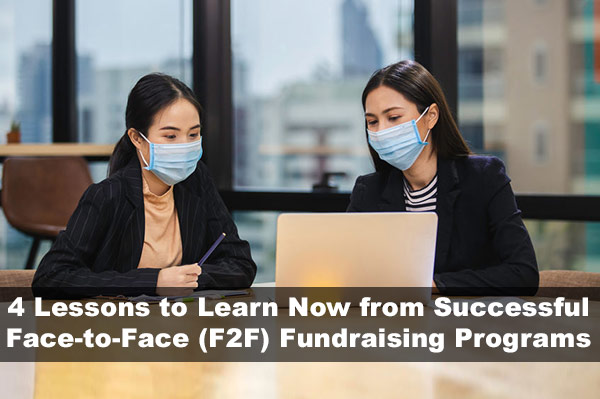We’re now over halfway through the year, and the COVID-19 pandemic (and its effects on fundraising) is sticking around for the foreseeable future. Rather than putting an indefinite pause on F2F fundraising and other acquisition efforts, it’s time to adapt your efforts for our socially distanced world.
For many organizations, this has taken a few forms, such as:
- Moving events to the digital sphere.
- Relying more heavily on social media and digital methods for communication.
- Pivoting to a virtual office.
- And more!
However, there’s a subset of fundraising organizations that may have struggled more than others to distance their efforts. We’re referring to charities that use face-to-face fundraising— the best method to acquire sustainer donors— and the challenges of maintaining social distancing requirements.
In this guide, we’re going to explore four successful face-to-face fundraising programs. When doing so, we’ll also review the following lessons that any program can implement for success during even the most challenging fundraising landscapes:
- Legitimize your F2F program.
- Give a “face” to the F2F fundraiser.
- Create an easy recurring gift process.
- Get creative to overcome a crisis.
Are you ready to learn from four face-to-face fundraising programs? Let’s get started.
Face-to-Face Fundraising Lesson #1: Legitimize your F2F program.
In some circles, face-to-face fundraising is battling a less-than-stellar reputation.
Since 2016, we’ve known F2F fundraising to be the leading source of direct sustainer acquisition and that organizations experience anywhere from 45 – 65% retention from these donors in year one. F2F fundraising has grown as much as 12% in some communities because of this! However, that doesn’t negate the fact that some people simply don’t enjoy being spoken to by someone they don’t know and are, therefore, unable to see the many benefits of F2F fundraising.
This was true even before there was a global pandemic that necessitates social distancing. However, we’ve also seen charities do a great job of overcoming this doubt.
For example, consider the CNIB Foundation, a charity organization that empowers people impacted by the loss of sight and blindness. This organization is continuing to use valuable face-to-face fundraising efforts during the pandemic, but is combatting the apprehension surrounding the practice in one simple way:
Educating their donors and legitimizing their program via their website.
On their website, CNIB is hosting an FAQ that includes answers to crucial questions surrounding their F2F fundraising practice. These include:
- Why are they continuing F2F fundraising even during these challenging times?
- What precautions are they taking to keep donors and fundraisers safe?
- What personal protective equipment is being utilized?
And more! By providing these answers, the CNIB team not only legitimizes their reasoning for continuing F2F during COVID-19, but also the safety measures they’re taking. This simple act can remove much of the doubt that potential donors may have.
Face-to-Face Fundraising Lesson #2: Give a “face” to the F2F fundraiser.
Another common challenge with face-to-face fundraising is that donors are unable to tell which F2F fundraisers are legitimate and “real,” as in actually tied to the organization they claim to be, or not. This is a real hesitation many would-be sustainer donors have— after all, they are signing up to make automatic recurring gifts to that organization for the foreseeable future!
It’s up to your organization and your F2F vendor to give potential sustainer donors the confidence they need to sign up for monthly donations through face-to-face fundraisers. The best way to do this? Well, just take a tip from Unicef and give a friendly face to your ambassadors!
On Unicef’s website, they give a summary of their face-to-face fundraising program. This breakdown includes:
- The geographic areas where you might run into one of their F2F ambassadors.
- Information about the face-to-face fundraising companies they’re working with to carry out these efforts.
- A comprehensive description of exactly what their canvassers will be wearing.
- A description of what their canvassers will speak about after approaching a donor.
- Images of their face-to-face fundraisers in full gear.
By providing this information, a potential donor is fully aware of which canvassers they can trust, and which they should be wary of.
There are two reasons why this is so important:
- Donors will be more likely to give via your F2F fundraisers when they’re approached by them.
- Donors will be less likely to get scammed by faux fundraisers, which ultimately protects your relationships with those donors and your reputation.
Whether you’re conducting a F2F campaign during a crisis or not, it’s a great idea to give your audience this same level of peace of mind, clarity and transparency.
Face-to-Face Fundraising Lesson #3: Create an easy recurring gift process.
Unlike other types of charity fundraising, the goal of face-to-face fundraising is specifically to build an organization’s sustainer donor base through recurring monthly donations. In fact, recurring monthly donations have resulted in a 30% increase in the number of multi-year donors acquired since 2016.
Sustainer donors are some of the most valuable charity contributors, as they provide a level of predictability and financial stability that one-time gifts simply can’t guarantee, without the requirement for additional conversion efforts. Sustainer givers provide funding that your charity can predictably budget around during a crisis, as you can predict the amount of funding you’ll have to utilize.
However, while they’re an incredibly valuable resource, there also comes some challenges with enrolling new donors into recurring giving. The biggest reason why building a sustainer giving program can be challenging is simple:
- Donors don’t want the hassle of maintaining their contribution.
Whether it’s updating their financial information or choosing to cancel/change their giving in the future, anyone that’s been enrolled in some sort of “subscription” will understand the apprehension around sharing their financial information.
However, we can draw inspiration from another organization successfully using F2F to circumvent this challenge: Plan International Canada.
Plan International Canada’s F2F fundraising program implements a payment-first processing solution to ensure that payments are captured and processed on the spot with every donor. The nonprofit takes this a step further by providing information directly on their website for donors that are looking to adjust their recurring giving plan. Not only do they provide a dedicated phone number for donors looking to make changes, but they also maintain a portal that donors can use to access their giving information independently!
Further, along with sharing this information on its website, Plan International Canada shares it in email communications.
Also read: Free Sample Appeal Letter for Crisis Funding
Face-to-Face Fundraising Lesson #4: Get creative to overcome a crisis.
The first three examples in this guide were of face-to-face fundraising programs that excel at reassuring donors in a variety of ways, whether it’s by legitimizing their program or providing clear giving options.
However, we’re going to explore the door-to-door fundraising agency perspective of Globalfaces Direct to discuss something equally important:
Creating face-to-face fundraising procedures that are truly safe for donors and fundraisers alike during the COVID-19 pandemic.
As you may have noticed, many face-to-face fundraising companies and programs went offline at the outset of the pandemic, understanding that it wasn’t safe to continue operations as normal. When doing so, these agencies outlined exact procedures to ensure the safety of all involved in the mission to fund charity organizations.
We encourage your face-to-face fundraising program to take similar precautions. For example, consider:
- Collaborating with provincial, state-level and municipal government officials to help build the case for F2F fundraising as an essential service to the nonprofit community.
- Equipping fundraisers with adequate PPE. When distancing isn’t possible, fundraisers should wear face masks. Additionally, equip them with custom personal protective equipment that speaks to the necessity of proper social distancing.
- Rolling out new cleaning procedures. Equip fundraisers with sanitizer and wipes to sanitize their hands, tablets, and phones between every interaction.
- Eliminating physical contact and close quarters. Canvassers should maintain the recommended six-feet distance and avoid any physical contact (such as shaking hands or sharing physical welcome materials) with donors.
- Making donor confirmation 100% contact-free. Rather than donors signing on a shared tablet, donor confirmation should be handled over the phone with a call center agent calling the donor’s phone directly. By calling the donor and receiving a verbal commitment, donor privacy is upheld in a safe manner.
With these steps, your face-to-face fundraising programs can successfully build your sustainer donor base, collect all needed information and store it in your CRM, and most importantly, do so safely— even during a global pandemic.
While face-to-face fundraising is a bountiful practice, it can be particularly challenging even during normal circumstances!
However, there are steps you can take, such as reassuring donors about your program and fundraisers, providing easy gift management options, and getting creative in the wake of a crisis, that can put your program ahead of the competition. Good luck!
——-
About the Author:
A seasoned executive with deep experience in the social sector, Naseem Saloojee lives by the motto that businesses can “do well by doing good.”
As CEO of Globalfaces Direct (GFD), a leading multi-channel outsourced fundraising provider for the not-for-profit sector, Naseem leads a team of 1000 fundraisers in over 70 offices across North America.
Before joining GFD, Naseem was SVP of Sales and a member of the executive team at Top Hat, a leading education technology company. In Naseem’s 4 years there, he guided the company to ~10X revenue growth, helped the company win Techvibes’ Canadian Startup of the Year award, and helped the company to be recognized amongst the fastest growing companies in the country by the Deloitte Fast50 and Profit500.
Previously, Naseem spent a number of years leading consulting teams for McKinsey & Company, where he was awarded the firm’s prestigious Social Sector Fellowship in economic development and worked with foundations, NGOs and government organizations across North America, the Middle East and Africa.
Naseem has an MBA from Harvard Business School and a Bachelor of Commerce degree from Queen’s University.


